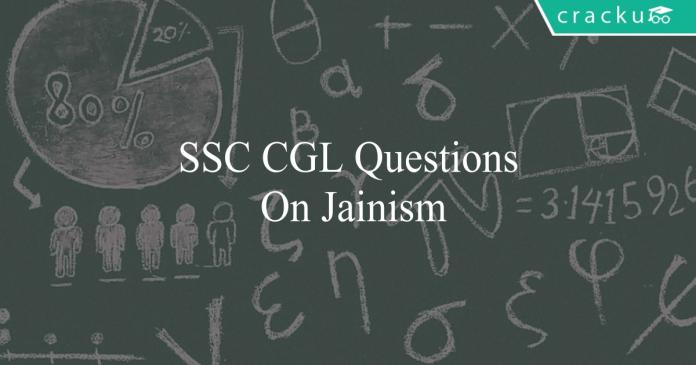SSC CGL Questions On Jainism
Download SSC CGL Jainism questions with answers PDF based on previous papers very useful for SSC CGL exams. 22 Very important Jainism objective questions for SSC exams.
Download SSC CGL Questions on Jainism
Question 1: Which of the following is common in both, Buddhism and Jainism ?
a) Non-Violence
b) Violence
c) Triratna
d) Truth
Question 2: Which Indian state has the most number of followers of Jainism?
a) Rajasthan
b) Gujarat
c) Madhya Pradesh
d) Maharashtra
Question 3: Which religion was propounded by Mughal Emperor Akbar in 1582 A.D., with the intention of merging the best elements of different religions?
a) Akbarnama
b) Ain-i-Akbari
c) Zij-i-Ilkhani
d) Din-e-Ilahi
Question 4: The Dilwara temple at Mount Abu in Rajasthan were built by the followers of?
a) Buddhist
b) Jainism
c) Hinduism
d) Sikhism
Question 5: Nalanda University was great center of learning especially ?
a) Buddhism
b) Jainism
c) Vaishnavism
d) Tantra
Question 6: Chandragupta Maurya was an ardent follower of ______________
a) Sikhism
b) Jainism
c) Buddhism
d) Jewism
Question 7: In which Indian Religion, there are 24 Tirthankaras?
a) Jainism
b) Buddhism
c) Hinduism
d) Sikhism
Question 8: Ashoka converted to which religion after the Kalinga war?
a) Jainism
b) Buddhism
c) Christianity
d) Judaism
Question 9: Which caves is a cultural mix of religious arts of Buddhism, Hinduism and Jainism?
a) Ajanta
b) Ellora
c) Elephanta
d) Badami
Question 10: With which religion is Kaivalya associated?
a) Buddhism
b) Jainism
c) Hinduism
d) Sikhism
18000+ Questions – Free SSC Study Material
Question 11: Milinda Panha is a?
a) Buddhist Sect
b) Buddhist conversation between Nagasena and the Greek ambassador Meander
c) Jainism Sect
d) Buddhist literature
Question 12: “Tripitakas” are related to?
a) Jainism
b) Buddhism
c) Hinduism
d) None of these
Question 13: Ajanta caves in Aurangabad District, Maharashtra are related to which of the following religions?
a) Buddhism
b) Jainism
c) Hinduism
d) Zoroastrianism
Question 14: Nirvana, the literal meaning of which is “blowing out” or “quenching”, is related to which of the religions?
a) Jainism
b) Hinduism
c) Buddhism
d) Zoroastrian
Question 15: The Nagarjuna Inscriptions provide information about:
a) Jainism
b) Buddhism
c) Brahmanism
d) None of the above
Question 16: Jainism was founded by?
a) Guru Nanak
b) Nataputta Mahavira
c) Siddhartha Gautama
d) None of the above
Question 17: The word Tirthankara is related to which religion?
a) Buddhism
b) Christianity
c) Jainism
d) Hinduism
Question 18: Syadvada was the fundamental basis of which religion?
a) Buddhism
b) Jainism
c) Vaishnavism
d) Shaivism
Question 19: The term “Anuvrata” is associated to which religion?
a) Mahayana Buddhism
b) Hinayana Buddhism
c) Jainism
d) Lokayata sect
Question 20: All souls day is a _____ festival.
a) Buddhism
b) Jainism
c) Christian
d) Muslim
100+ Free GK Tests for SSC Exams
Question 21: The concept of Triratna belonged to
a) Sikhism
b) Jainism
c) Buddhism
d) Zoroastrianism
Question 22: Vedic religion was also known as ……..
a) Buddhism
b) Bralunanism
c) Jainism
d) Hedonism
Question 23: The chinese buddhist monk faxian who travelled from ancient China to ancient India to acquire which texts?
a) Shinto
b) Taoism
c) Jainism
d) Buddhism
Question 24: Ellora caves in Maharastra are associated with which religion?
a) Buddhism & Hinduism only
b) Buddhism, Jainism, Sikhism
c) Buddhism, Jainism, Hinduism
d) Buddhism & Jainism only
Answers & Solutions:
1) Answer (A)
2) Answer (D)
3) Answer (D)
The Din-e-Ilahi was a syncretic religion propounded by the Mughal emperor Akbar in 1582 CE, intending to merge some of the elements of the religions of his empire, and thereby reconcile the differences that divided his subjects. The elements were primarily drawn from Islam and Hinduism, but some others were also taken from Christianity, Jainism, Sikhism and Zoroastrianism.
4) Answer (B)
5) Answer (A)
6) Answer (B)
7) Answer (A)
8) Answer (B)
9) Answer (B)
10) Answer (B)
11) Answer (B)
12) Answer (B)
13) Answer (A)
14) Answer (C)
15) Answer (B)
16) Answer (B)
17) Answer (C)
18) Answer (B)
19) Answer (C)
20) Answer (C)
21) Answer (E)
22) Answer (B)
23) Answer (D)
24) Answer (C)





